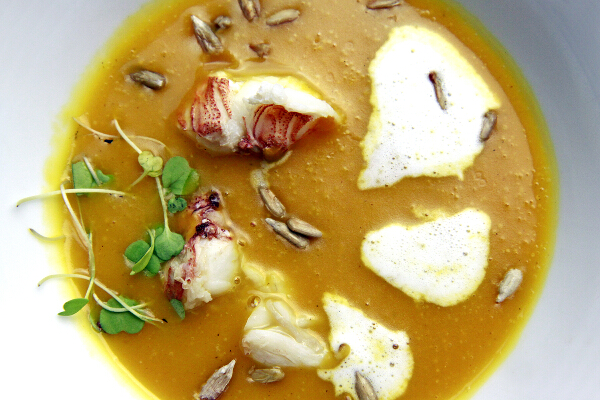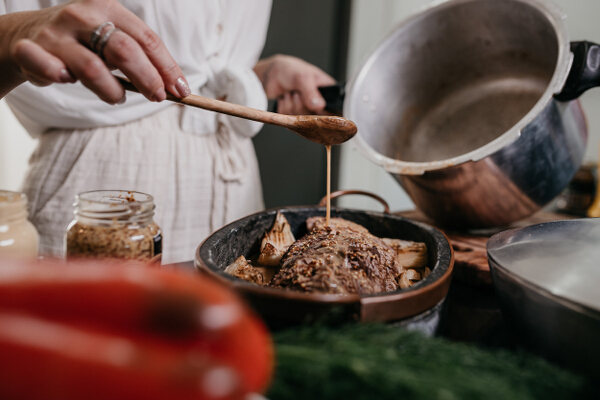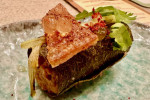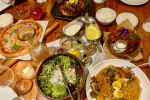My friends (and family) are often surprised to learn I actually know how to cook. Haha. That’s because I spent my whole life perfecting everything I get myself into—from school to my career—except homemaking. That is, until I married a man whose home and business are in a remote farm in Iloilo Province, and I had to give up my career, pack up my city life, and learn to be a full-time homemaker and eventually a mom.
Prior to becoming a mom, my husband was happy with the salads, pasta, sandwiches, and occasional fried food that I prepared. But then I became a mom, weeks later the pandemic happened, and my child eventually had to be fed solids. I had to learn to not just cook healthy food sans the preservatives that make cooking easier and more convenient, but also work with fresh ingredients we grow in the farm and are available in the nearby “tiangge” or neigborhood store selling vegetables, meat, and seafood because we couldn’t go to the city to buy our usual groceries.
The best thing to cook when you’re working with fresh and locally available ingredients? Traditional dishes. Everyone has their favorite traditional dish, and as an Ilonggo, my husband has several local favorites. One of them that my daughter and I also love is Linutik, which is primarily made of mashed squash (kalabasa) and coconut milk (gata), with other ingredients like bits of pork or shrimp and malunggay (or moringa leaves, something we had in abundance in the farm and an essential when I was breastfeeding).
Everyone has their favorite traditional dish, and if, like me, you’d like to learn how to make it from scratch, you’d find that it’s easier than we might think. The huge plus is, home-cooked meals made from fresh ingredients are more often than not much healthier than ordering takeout or getting a premade meal at the grocery store. I’m with you in thinking that it seems like a lot of work, but you’d be surprised how easy some of the recipes can be. All it takes is learning how and you’ll soon be able to cook traditional dishes from scratch—believe me, I’ve been through the whole process. In this blog post, I’m going to share how you, too, can get started on gaining the skills and confidence to make more homecooked meals.
Photo from unsplash.com (Vitor Monthay)
Do your research
As with many things in life we don’t want to mess up, it’s always good to start by doing a little research. In my own kitchen journey, the first thing I do once I’ve decided what to cook or when my husband or child requests a particular dish is to research how to make it. This process includes asking my mom how she does it, or asking her for a recipe, asking locals how to make their traditional dish, or simply going online and finding the best recipe to follow. This step also helps me determine what ingredients I need before I cook.
Before diving into the recipe for a traditional dish, I also like to find out a little more about the dish and its origin story. Apart from the how-to, I like to ask locals the dos and don’ts in preparing the meal. I also try to look out for helpful tips and tidbits online to enhance my cooking experience—be it how to make it easier while remaining authentic, or how to make it healthier, especially for my child. It’s all about finding different helpful resources and learning to follow the process. For instance, lately our family has been into soups—in an effort to eat healthier and put more vegetables and liquids into our diet—so I’ve been actively researching various soup recipes online, like this traditional split pea soup recipe I found.
Gather your ingredients
Before I even start cooking, I always do an inventory of what ingredients I have available and if I have everything I need to cook the dish I’m planning in the first place. When planning to make a traditional dish from scratch, be sure to check out your local store or market for as many authentic ingredients as possible. Living in the middle of a farm during the pandemic proved to be a blessing since we were surrounded by a wide variety of fruits and vegetables we could eat and only needed to buy mostly meat and seafood from the local market.
If you’re making a traditional dish from another country, like the split pea soup I mentioned above, it would be nice if there’s an international market nearby where you can buy the necessary ingredients, as it’s important to acknowledge that some recipes may require specialty ingredients if you truly want to keep the dish as authentic as possible. Thanks to the boom in online shopping during the pandemic, it’s now also much easier to find ingredients in online shopping platforms.
Start small
So now we get to cooking! The best way to begin is by starting small: Start by mastering a few simple dishes before attempting more complicated recipes. Traditional dishes usually take time and patience to master, so don’t worry if it takes some trial and error before you get it just right. Taking baby steps when learning how to cook traditionally will give you the confidence and strategies needed to eventually perfect more recipes over time.
Follow instructions carefully
I cannot stress this enough: You really need to follow instructions carefully right from the beginning. If something doesn’t seem right or if instructions are unclear, don’t hesitate to do more research or ask someone who is familiar with making the traditional dish you’re cooking. Sometimes you might need to read two or three recipes to get it right. When in doubt, go with the most authentic approach. This is especially true when it comes to spices and herbs. Once you’ve mastered them, over time you can go on to adjust them according to your own tastes and preferences as needed. Even with cooking, you need to learn the rules before you can purposely break them.
Learning how to make traditional dishes from scratch at home is a great way to connect with history and culture—plus, it’s fun too! Just remember that patience is key. Don’t expect perfection on your first try (or even second). Take your time and follow instructions carefully, adjusting as needed along the way until you find what works best for you. With practice, you’ll soon be able to perfect your family’s favorite meals.

























